From Challenger to Leopard: How Ukraine’s tanks compare to Russia’s
New footage purports to show Britain-made Challenger 2 tank destroyed in combat for first time, Andy Gregory reports

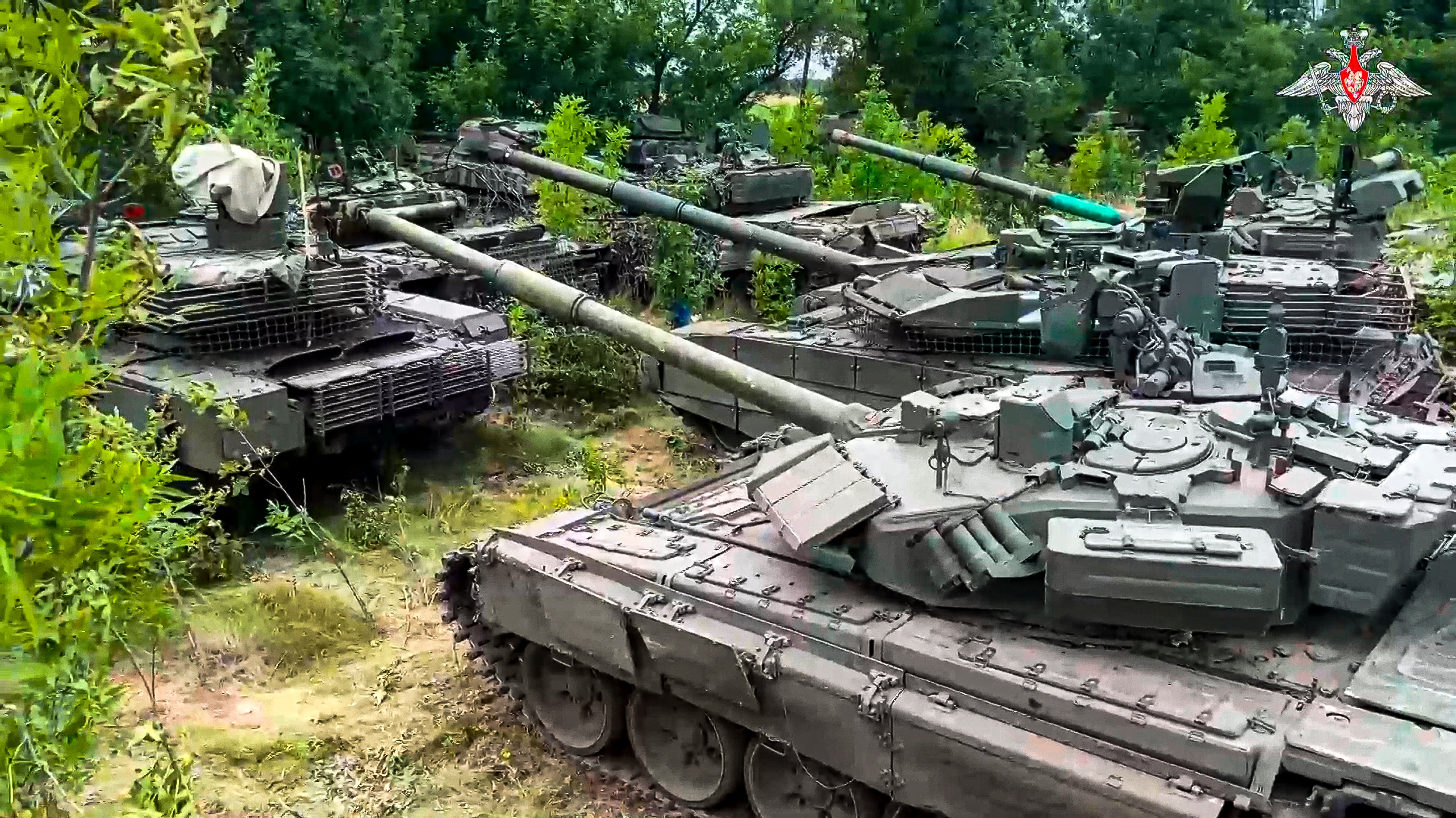
Your support helps us to tell the story
From reproductive rights to climate change to Big Tech, The Independent is on the ground when the story is developing. Whether it's investigating the financials of Elon Musk's pro-Trump PAC or producing our latest documentary, 'The A Word', which shines a light on the American women fighting for reproductive rights, we know how important it is to parse out the facts from the messaging.
At such a critical moment in US history, we need reporters on the ground. Your donation allows us to keep sending journalists to speak to both sides of the story.
The Independent is trusted by Americans across the entire political spectrum. And unlike many other quality news outlets, we choose not to lock Americans out of our reporting and analysis with paywalls. We believe quality journalism should be available to everyone, paid for by those who can afford it.
Your support makes all the difference.It was a decision hailed by a top aide to Ukraine’s president Volodymyr Zelensky as “a real punching fist of democracy” against Russia’s invasion – the fact that the UK, US and Germany would provide tanks to Kyiv.
The 14 Challenger 2 tanks from Britain and 18 Leopard 2 tanks pledged by Germany reached Ukraine in March, while the Abrams tanks promised by the United States are finally expected to start arriving this month.
The extent to which the tanks have been deployed on the battlefield in Kyiv’s grinding counteroffensive effort this summer is unclear, but they are likely to be used to capitalise upon any breakthrough in Russia’s heavily fortified defensive lines.
However, on Tuesday, footage purportedly captured near the Zaporizhzhia village of Robotyne – where Ukraine is reported to have enjoyed promising gains – appeared to show a burnt-out Challenger 2 tank.
It is believed to mark the first time a Challenger 2 has been destroyed in combat since the tanks were first deployed in 1994, save for a friendly fire incident in Iraq in 2003.
While the Western tanks have undoubtedly bolstered Kyiv’s firepower, they appear to have so far been relatively constrained by Russia’s dense minefields and other fortifications, but military experts have said they could be key in the event of any major breakthrough.
Although only pledged in small numbers, the decision to supply tanks marked a gear change in Nato’s support for Ukraine, where both Moscow and Kyiv’s forces had been fighting largely with Soviet-built tanks.
The Independent has taken a look at the various tanks either already, or soon to be, at play in the war, how they compare, and what this could mean for the war effort on each side.
Challenger 2
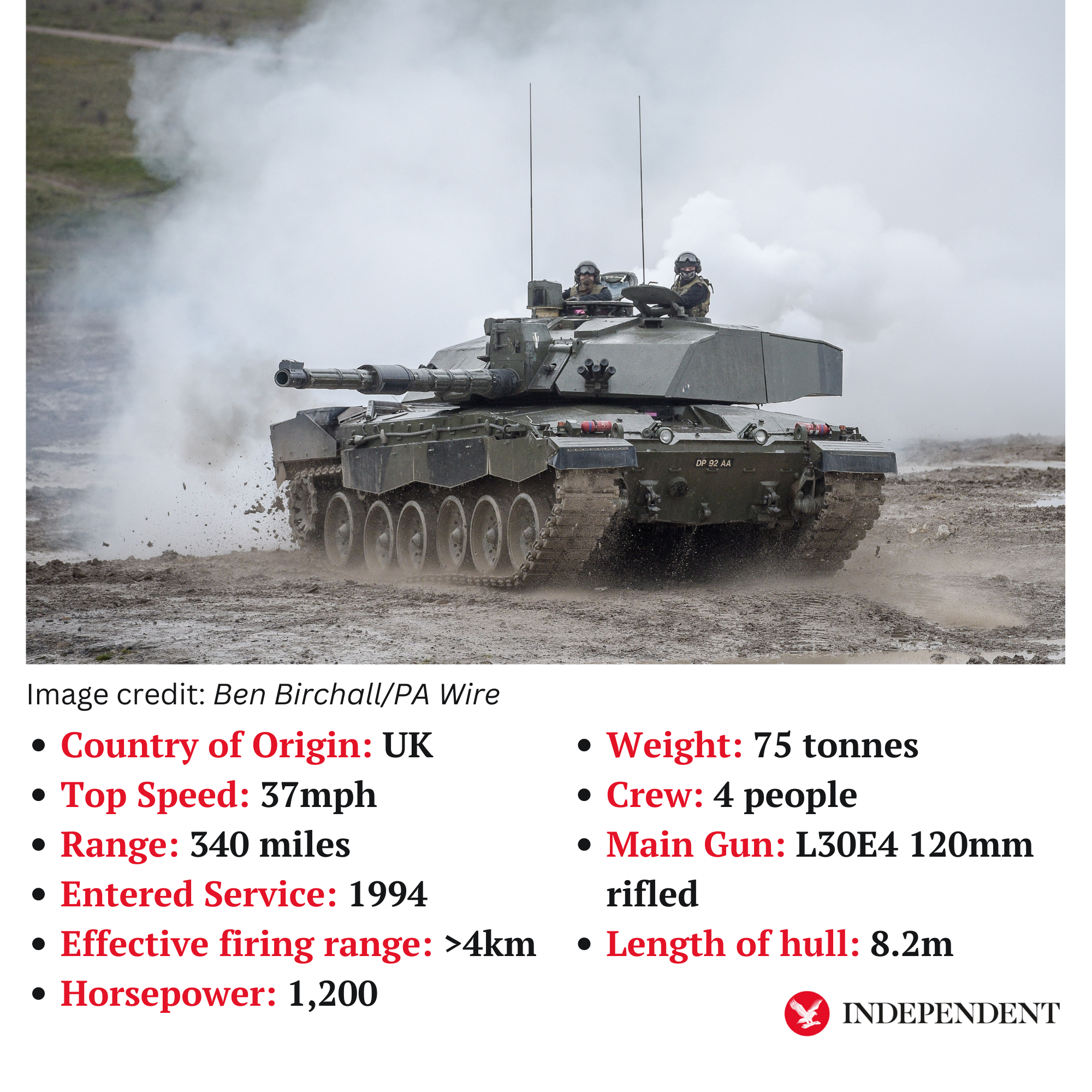
The UK has sent 14 of its Challenger 2 tanks to Ukraine. Developed by Vickers Defence Systems, now BAE Systems, these 8.3-metre-long tanks have since been deployed in Bosnia, Kosovo and Iraq, and are designed to destroy other tanks.
It is the heaviest of all three Western tanks on offer, and although capable of firing Nato rounds, uses a different kind of ammunition for its main rifled gun – high-explosive squash-head ammo – and is slightly slower, sporting a 1200-horsepower engine, 300 short of its contemporaries, according to Dr Marina Miron, of Kings College London’s war studies department.
Its 120mm rifled gun is said to have an effective firing range of at least 3km using armour-piercing rounds. The Challenger also claims the furthest tank-on-tank kill shot in military history, destroying an Iraqi vehicle at a range of 4,700 metres during the Gulf War in 1991.
This week, one Ukrainian serviceman extolling the machines as “a sniper rifle among tanks” claimed a Challenger 2 had “undoubtedly set a world record [in Ukraine] when it hit a T-55 [tank] from a distance of more than five kilometers”, adding: “You’re basically just scaring the Russians with the sound of the engine.”
This tank prioritises firepower and protection – provided by “world-class” Dorchester 2 armour – over speed, making it slightly slower than its counterparts, but this is offset by its “accuracy and lethality”, according to the British army.
“As far as protection goes, Challenger 2 is very well protected. It would take a number of hits from a T-72 [Soviet-era tank operated by Russia] and the crew would survive,” Hamish de Bretton-Gordon, a former commanding officer in the British army’s Royal Tank Regiment, previously told CBS News.
Leopard 2
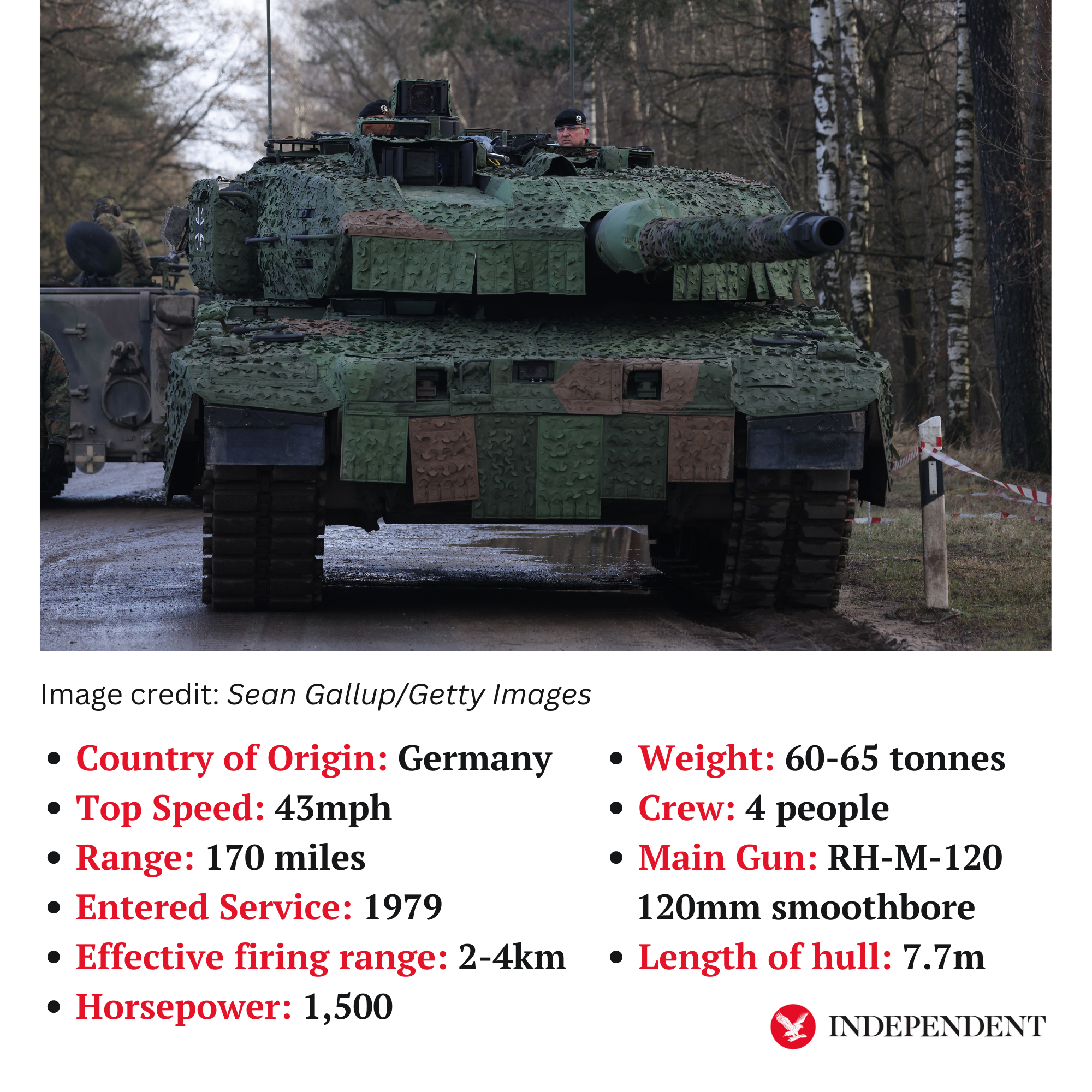
More than 2,000 Leopard 2s sit in European and Canadian arsenals, with a reported price tag of around £5m each – and a consortium of Nato countries including Canada, Spain and Denmark have so far pledged more than 100 of the battle tanks to Ukraine.
Designed during the Cold War, as part of a programme that also birthed the Abrams, to fight the Soviet-era tanks currently being used in Ukraine, Leopards are designed to withstand 125mm penetrator ammunition fired from 1,500 metres and “are one of the best armoured tanks”, according to Dr Miron.
Fitted with two coaxial light machine guns alongside its main guns, the Leopard is prized for its high manoeuvrability and adaptability, and is viewed as particularly suitable for Ukraine, with relatively lower fuel consumption than its American counterpart.
“These are the Mercedes BMW supertanks of the world,” Hamish de Bretton-Gordon, a former commanding officer in the British army’s Royal Tank Regiment, told CBS News, adding: “I would want at least 10 or 15 T-72 survivors [used by Russia] up against one of them.”
Analysis by the Dutch open-source intelligence group Oryx suggests that, of the at least 70 Leopards thought to have been received by Ukraine, just seven have so far been destroyed in combat, with nine others damaged, and three damaged and abandoned.
Damaged tanks are being repaired at depots in Poland and Germany and will later return to the frontline, while Forbes reported that modifications to the Leopards mean it is possible that nearly every crew member in the destroyed tanks may have escaped the vehicle before it burned or exploded.
M1A2 Abrams
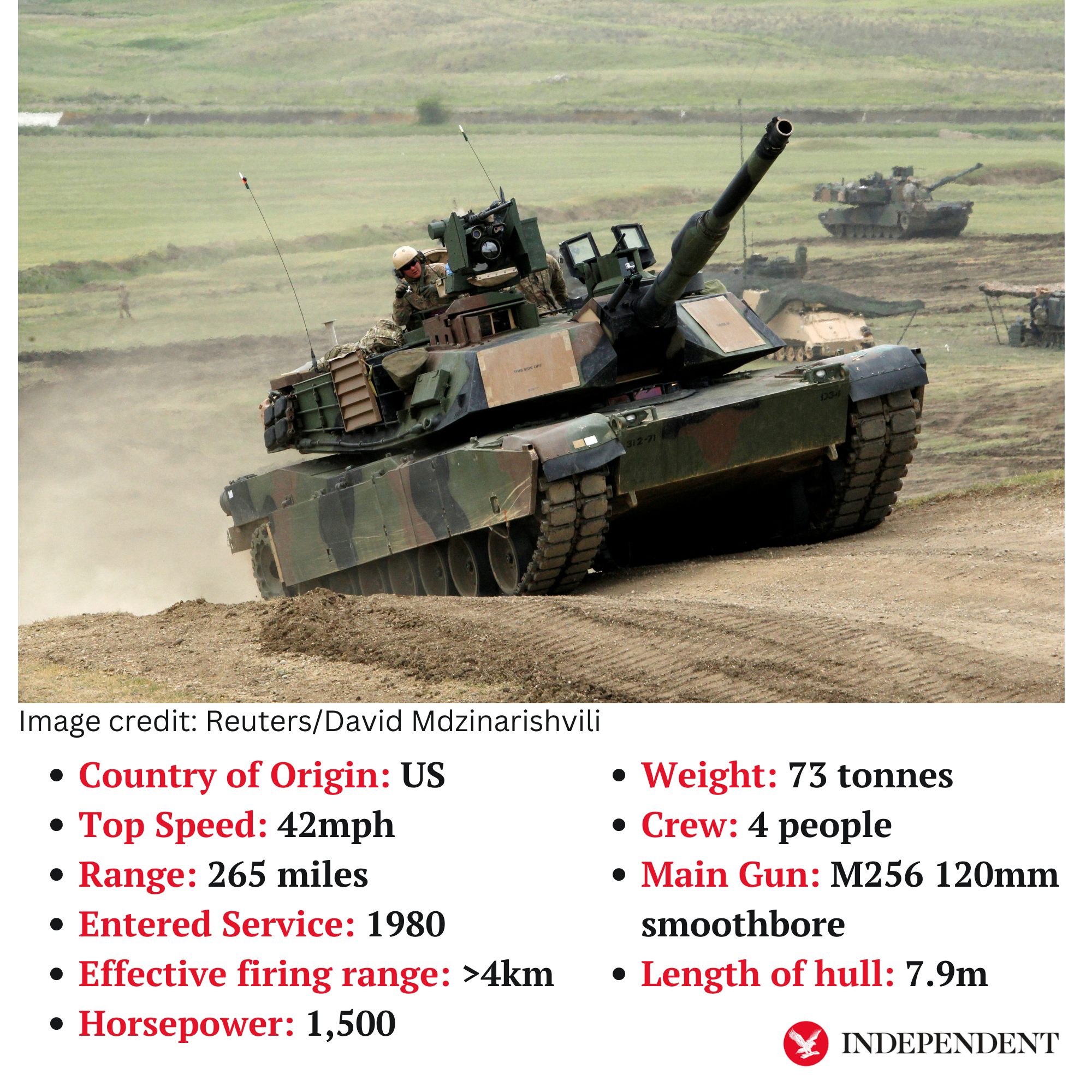
Designed by Chrysler Defence during the Cold War and since used in Bosnia, Iraq and Afghanistan, the Abrams is the main battle tank of the US army, while Australia, Saudi Arabia, Egypt and Poland all own export versions. Ukraine is now set to receive 31 of the tanks – enough for an entire battalion.
The Abrams is reported to be the first tank in which the commander and gunner are both provided with optical and thermal sights – including a periscope spanning 360 degrees – which allows them to simultaneously track separate targets in what is called a “hunter-killer” capability.
The US army credits the tank – reported to cost up to $10m (£8m) once training and maintenance is factored in – with “lethal firepower, unparalleled survivability, and audacious manoeuvre”, while Dr Miron told The Independent that the 120mm depleted uranium rounds it fires, known as “silver bullets”, are “probably the most lethal to any armour”.
After months of indecision, amid fears over provoking Russia, Reuters reported this week that the US will include the depleted uranium rounds in its package to Ukraine, which Britain vowed to do in March.
The “main difference” between the Abrams and the Leopard lies in the former’s gas turbine engine, which requires jet fuel, meaning troops would need a separate supply chain to power the vehicles, according to Dr Miron – which had sparked doubts among US officials over its suitability for Ukraine.
“The maintenance and the high cost that it would take to maintain an Abrams — it just doesn’t make sense to provide that to the Ukrainians at this moment,” the Pentagon said in March.
Politico reported this week that some 200 Ukrainians have completed training in Germany on the Abrams, as US defence officials expressed hope the looming shipment could help Kyiv breach Moscow’s defences.
The Abrams is “one hell of an armored vehicle,” a US defence department official said. But “it’s not a silver bullet. Ultimately, it’s Ukraine’s determination to break through that matters most.”
T-72
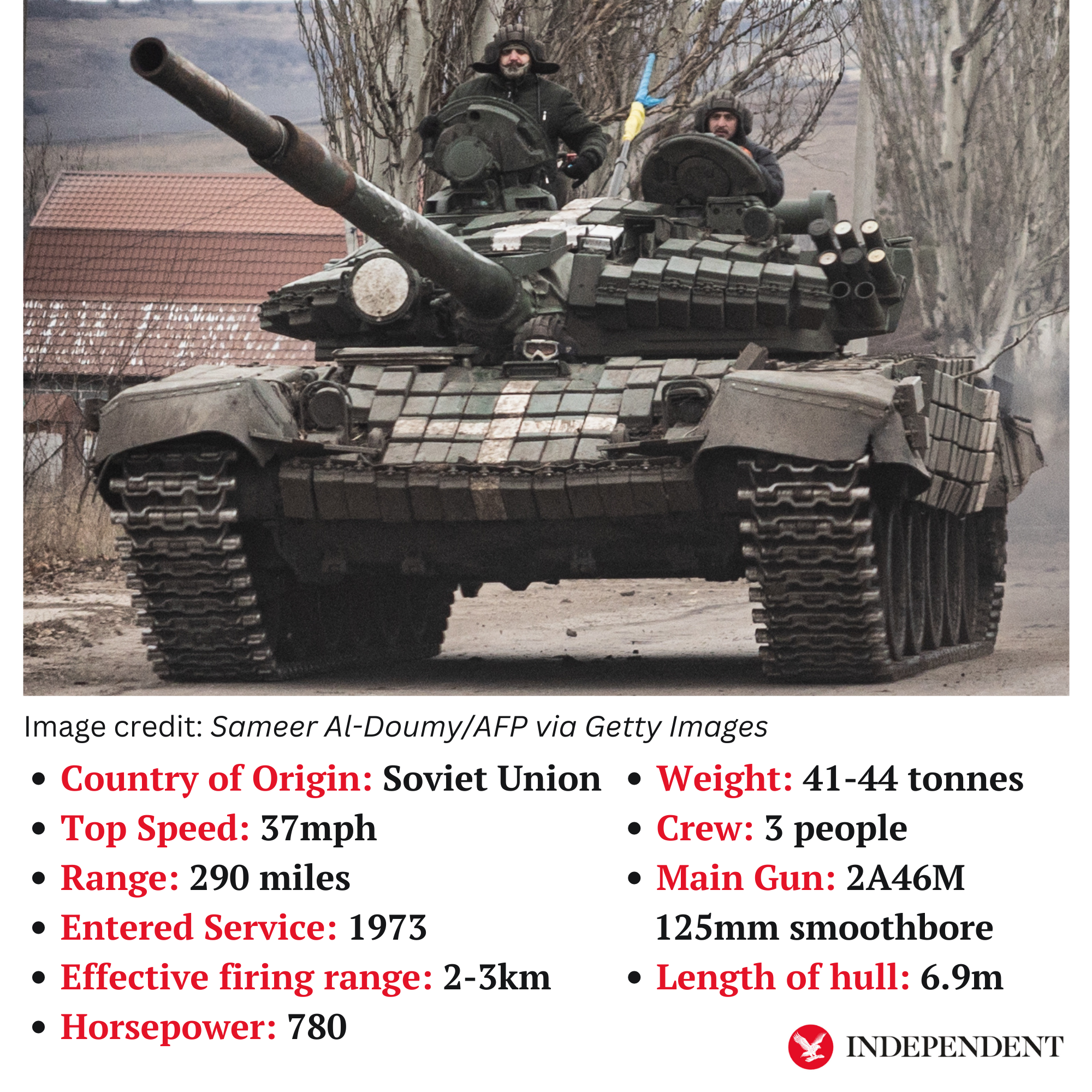
Both Ukraine and Russia have been relying heavily on Soviet-era T-72 tanks, which despite representing a new level of firepower upon their introduction in 1973 – with their large 125mm cannons – now find themselves somewhat outgunned by the next generation.
Upgraded versions are said to have a limited “hunter-killer” capability, but lack the panoramic sight enjoyed by the commander in newer tanks. Like other models on this list, most T-72s are also fitted with a laser rangefinder, which adjusts the main gun before it fires in order to account for wind, temperature and the tank’s movement.
As the Red Army’s main tank until the Soviet Union’s collapse, tens of thousands of these lightweight and relatively agile models are believed to have been produced, with Wired reporting in 2015 that used models could be bought by civilians for just $50,000.
These are the main tanks currently used by Ukraine, which also uses Soviet T-64s and T-80s, and as of March accounted for most of the 450 tanks Kyiv had been supplied with by its allies since Russia’s invasion last February, given its existing familiarity with the vehicles.
But in terms of its armour, the T-72 is quite “light”, mainly using welded steel, meaning that the crew protection element “is certainly much weaker than other tanks”, according to Dr Miron – evidenced by the continual flow of images showing these tanks with their turrets blown off.
Washington has pledged to upgrade some of Kyiv’s stock of T-72s with new optics, communications, and armour, which the Pentagon claimed would make them “the most technically advanced tanks on the battlefield”.
T90
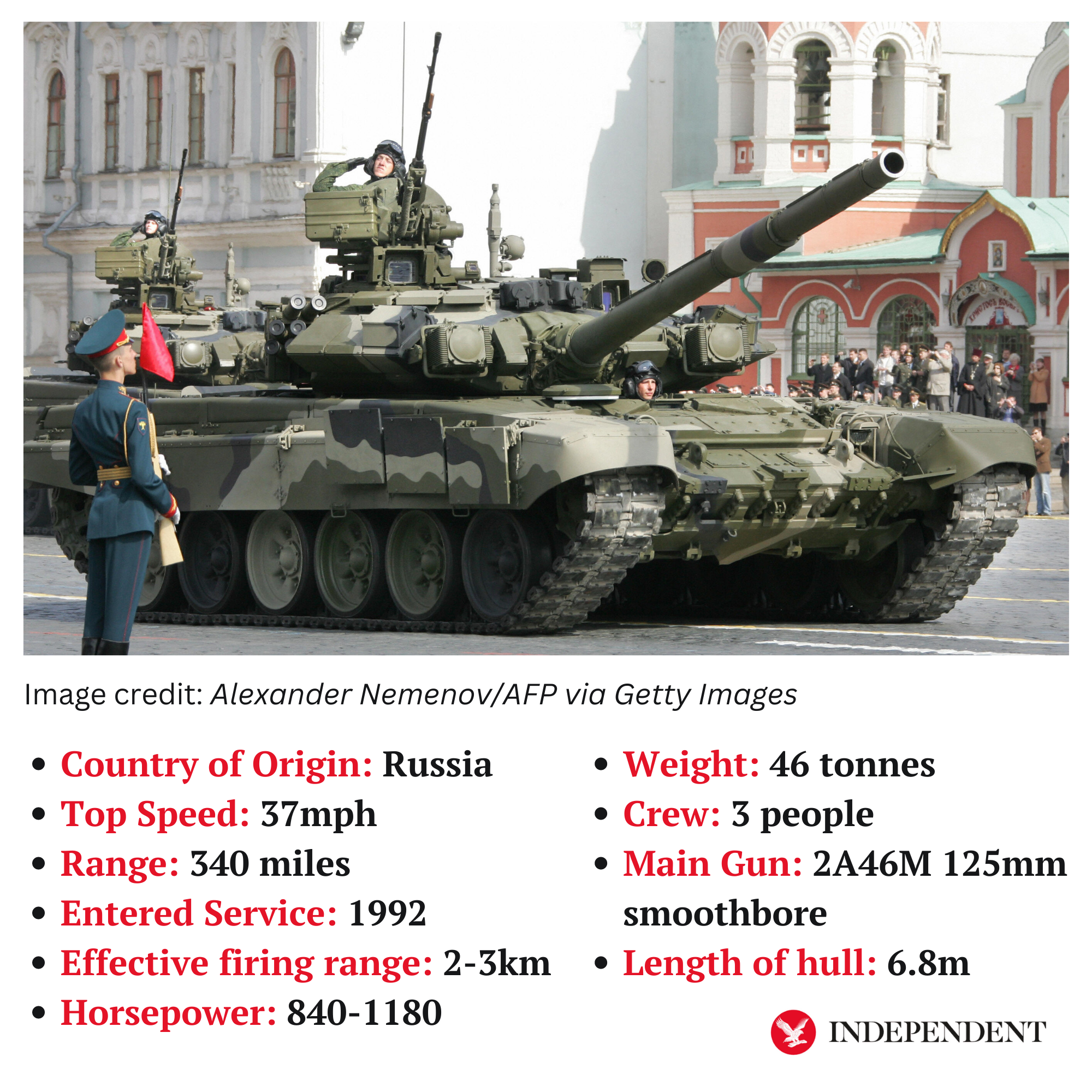
Designed by Russia as an improvement on its Soviet predecessors, following heavy losses during the Chechen and Gulf wars, some versions of Moscow’s newest tank are, on paper at least, even better than their Nato counterparts, boasting a superior gun and anti-tank missile system.
The T90’s large 125mm gun can fire different types of ammo, including HEAT and HE-Frag (high-explosive fragmentation) ammo, as well as the 9M119 Reflex (Refleks) anti-tank guided missiles, which have a maximum range of up to 4,000m, according to Dr Miron.
The T-90S model boasts both conventional and explosive reactive armour, and along with its Western counterparts has some modern detection systems such as infrared, thermal vision, and day and night sight, Dr Miron said.
But Britain’s Ministry of Defence said last August that it was “highly likely” that many Russian crews lacked the training to properly maintain explosive reactive armour – as it sought to account for the “heavy attrition” suffered by Russia’s main battle tanks in Ukraine.
According to the Military Balance database, Russia had around 3,330 operational tanks in total shortly before its invasion of Ukraine, with another 10,000 in storage.
For its part, Ukraine is thought to have started the war with just shy of 1,000 Soviet-made T-64s, T-72s and T-80s.
T-14 Armata
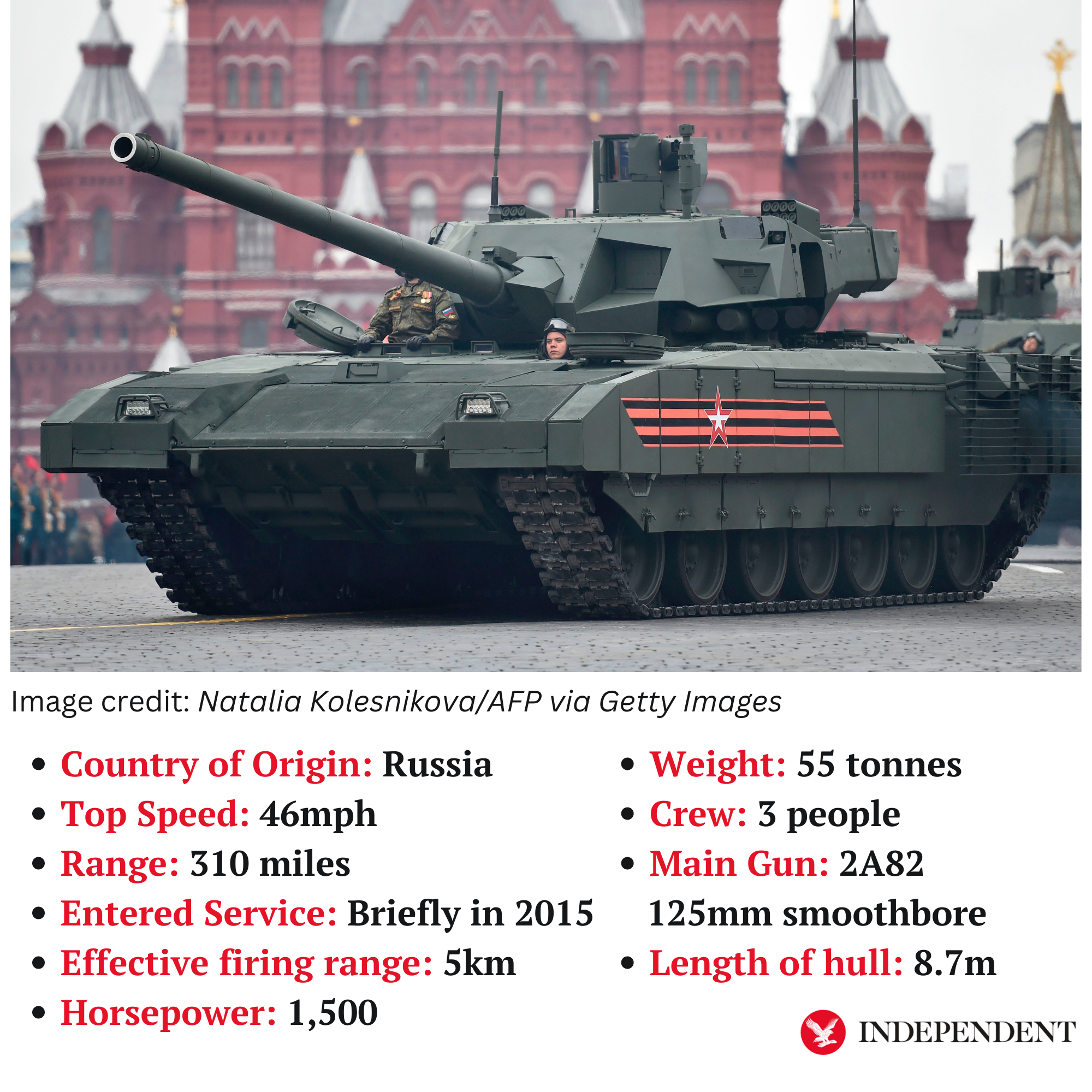
First revealed during Russia’s 2015 Victory Day parade, this tank has been touted by Moscow as marking an ambitious departure from its pragmatic and cost-efficient predecessors.
However it is still in development. While Russian state news agency Tass claimed in July that a number of T-14s had been deployed in Ukraine to test their performance in “real combat conditions,” it reported a month later that they had been withdrawn for further tweaks.
T-14s are claimed to be capable of firing guided anti-tank missiles with a range of 5km, potentially putting low-flying helicopters at risk.
The fastest of the tanks listed, its armour has been updated to a combination of steel, ceramic, and composite materials, with the potential for further modules to be added on, and is claimed to be invulnerable even to RPGs and to nuclear, chemical and biological weapons, according to Dr Miron.
However, the British Ministry of Defence suggested in January that their deployment was “likely to be a high-risk decision for Russia”, with Russia’s 11-year development programme “dogged with delays, reduction in planned fleet size, and reports of manufacturing problems”.
Having already been hampered by logistics issues in Ukraine’s vast territory, Moscow could struggle to adapt its supply chains to incorporate these larger and heavier tanks, according to the ministry.
Therefore, any deployment would likely be primarily “for propaganda purposes”, with production probably only in the low tens, and commanders “unlikely to trust the vehicle in combat”, British intelligence analysts said.
What does this mean for the Ukraine war?
All three Western tanks are more agile than Russia’s T-models, which can’t reverse at speed, according to Dr Ralf Raths, director of the Panzer Museum in Munster, Germany.
“Imagine a boxer who cannot move freely in the ring, but only in one direction,” he previously explained. “The other boxer, who can move in all directions, has a big advantage, and that is the case with the Leopards.”

However, Dr Miron also warned that neither the Challenger nor the Leopard has seen many battles and, despite its seemingly superior armour, the Leopard “has seen some problems in Syria and proved to be vulnerable to mortars and mines”.
Niklas Masuhr, of the Zurich-based Centre for Security Studies, warned in January that the addition of tanks alone wouldn’t be “a game changer or a war-winning technology, anything like that”.
“You can’t just deploy a bunch of main battle tanks and assume they will win,” he said. “They’re very valuable, but you still need to use them in the correct way and integrate them with all the other military tools that you have at your disposal.”
According to the open-source monitoring group Oryx, Ukraine has lost at least 642 tanks, of which 415 were destroyed and 143 captured by Russia, which has lost at least 2,290 tanks – of which 1,482 have been destroyed and 549 captured.




Join our commenting forum
Join thought-provoking conversations, follow other Independent readers and see their replies
Comments